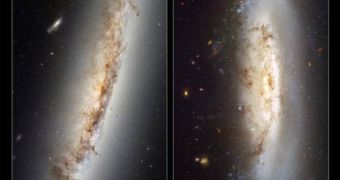One of the latest images collected by the Hubble Space Telescope before its overhaul – earlier this year – shows stellar winds wreaking havoc through a pair of galaxies, preventing stellar formations from taking shape inside and distorting their shapes significantly. The phenomenon, known as “ram pressure stripping,” was observed in the Virgo Cluster, where the two galaxies were located. Inside the cluster, many galaxies move through hot gas at high speeds. These swift motions give birth to the winds, which in turn tug and pull on the formations, creating some of the most peculiar-looking galaxies in the known Universe, Space reports.
Ram pressure can best be described as the drag force that an object experiences when moving through a fluid. It may not be too far-fetched to compare it to the effects you feel on your face, when riding your bicycle against the wind, or at high speeds. In the case of galaxies, the effects are a bit more intense, as demonstrated by NGC 4522, which is located about 60 million light-years away from the Earth. Ram pressure is currently in the process of stripping all of the gas contents away from the galaxy, astrophysicists reports.
This happens because the galaxy simply moves too fast through the cluster. The drag force is experienced from the external gas clouds and essentially makes its own gas lag behind. This can be compared to a car making a good start, but leaving its hood behind. According to scientific measurements conducted on the formation, NGC 4522 is moving at a speed of about six million miles per hour (ten million kilometers per hour) through the gas inside the Virgo Cluster. As a direct result, areas of stellar formation can only be seen to the right and left of the center.
The second galaxy Hubble imaged, called NGC 4402, is also subjected to the direct effects of ram pressure stripping. This time, swirls of dust and gas can be seen trailing behind the galaxy, as space winds rip them apart. These types of studies are especially important, because they could potentially increase our level of knowledge on what it is that drives the evolution of galaxies. Additionally, this line of research could also provide astronomers with new, more precise models on the ratio of young-star formation, especially in the younger regions of the Universe.

 14 DAY TRIAL //
14 DAY TRIAL //